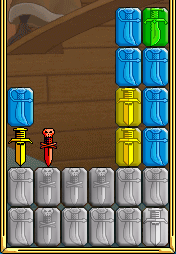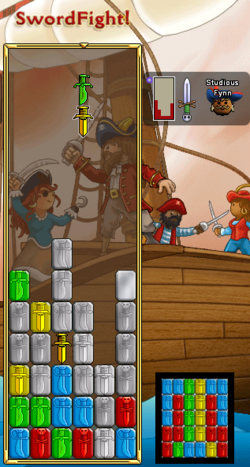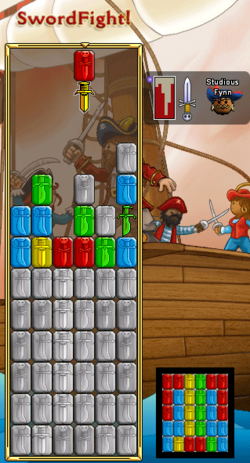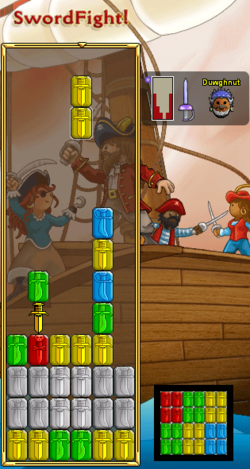Swordfighting drop pattern
| This article needs to be updated. | |
| Parts of this article are no longer up to date. Please update it to reflect recent events, and remove this template when finished. |
(Saber/Falchion patterns need updating since Release_2024-07-25)

Each sword has a particular drop pattern, which indicates the color and arrangement of attacks that are sent to an opponent during a swordfight. This pattern is determined by the type of sword and the sword colors, and cannot be changed after the sword has come into existence. The drop pattern is the only property of a sword to have a direct effect on the swordfighting puzzle. All patterns are exactly 6 columns wide, but the number of rows in each pattern varies between 3 and 6 (inclusive).
Each of the different drop patterns confers both strategic advantages and disadvantages to the pirate who uses a sword with that pattern. Some patterns, for example, may produce attacks that are difficult to remove from the screen (clear) if they are sent using strikes. However, those same attacks may be easier to clear if they are sent using sprinkles. A great deal of swordfighting strategy revolves around playing to the strengths of a particular sword and exploiting the weaknesses of the opponent's sword.
Note: throughout this article, the rows of drop patterns and swordfighting boards are labelled 1 through 13 (up to a maximum of 6 for drop patterns), where 1 is the lowest row. Similarly, the columns are labelled 1 through 6, where 1 is the leftmost row. This is done to make explanations shorter.
Contents
Viewing a pattern
The sword owner can view the drop pattern by hovering the mouse over the sword when it is in the booty panel, or in a sword rack. Additionally, the owner can view his or her pattern during a swordfight. Iron monger shoppes and stalls also display sword drop pattern previews.
Pattern mechanics
When incoming attacks from an opponent are received, they take one of two forms. Sprinkles, which are individual gray blocks, and strikes, which are sword-shaped silver blocks which enter the board horizontally or vertically - and which become gray blocks on the following turn. Refer to the links below for information on how sprinkles and strikes are generated from player attacks. Note that if a player receives attacks from multiple opponents, each attack will match the drop pattern of the respective attacker. Once attacks have entered the board and have settled, the opponent's drop pattern is mapped onto them as follows:
Sprinkles
All sprinkles use rows 1 and 2 of the drop pattern. The first sprinkle to enter column X will become the same color as the block in row 1 and column X in the drop pattern. A second sprinkle in column X will match the block that is on row 2, column X of the drop pattern. If more layers of sprinkles are received during that same turn, the drop pattern begins from row 1 again, such that the third layer of sprinkles matches row 1 of the drop pattern, the fourth layer matches row 2, the fifth matches row 1, and so on. Note that this only applies to sprinkles received during one turn; if multiple layers of sprinkles are received at a rate of one layer per turn, they are treated as single layers and will all use row 1 of the drop pattern.
As an example, 15 sprinkle blocks land on the board: 12 fill rows 5 and 6, and the remaining 3 blocks fill columns 4, 5, and 6 of row 7. In this case, rows 5 and 6 will match the bottom two rows of the drop pattern. The remaining sprinkles in row 7 will match row 1, columns 4 through 6 of the drop pattern.
Strikes
Strikes may be either vertical or horizontal, and both make use of the whole drop pattern - unlike sprinkles, which are restricted to rows 1 and 2.

For a vertical strike, the blocks added to the board by the strike attack will match the corresponding columns of the drop pattern from row 1 upwards. As an example, a 2x3 (two blocks wide, three blocks high) sword falling in columns 5 and 6 will turn the same set of colors as the first three rows of columns 5 and 6 on the drop pattern. If a sword's length in blocks exceeds the number of rows in the drop pattern, the pattern will fold around and repeat from the fourth row from the top. These four top rows will then repeat until the sword's length is reached. Any rows which fall outside this range are not repeated. In the case of a 2x8 vertical sword, sent by a saber (6 rows in the drop pattern), rows 1 through 6 of the sword will match those of the drop pattern row-for-row. Rows 7 and 8 of the sword will match rows 3 and 4 of the drop pattern. Rows 1 and 2 of the drop pattern are only sent once in this example. If a drop pattern has less than 4 rows (such as the stick with 3 rows), the entire pattern will be repeated from row 1 instead of the 4th row from the top.
Horizontal strikes behave similarly to vertical strikes, but use a rotated version of the drop pattern. Strikes originating from the left-hand side use the left side of the drop pattern, so that the top row of the strike matches the pattern column 1, the second row down of the strike matches the pattern column 2, and so on. Strike originating from the right-hand side mirror this behaviour. Although a horizontal sword greater than 6 blocks horizontally will be sent as a vertical sword, it is possible that a horizontal sword - particularly of lengths 4 or greater - may exceed the height of some swords' drop patterns. In this instance, the drop pattern repeats according to which side the sword entered from. For right-sided swords, the pattern repeats from column 4 to column 1 after rotation by 90 degrees counter-clockwise. For left-handed swords, the pattern repeats from column 3 to column 6 after rotation by 90 degrees clockwise.
Visual examples
The following images illustrate how drop patterns are applied to blocks in the swordfighting puzzle:
| Sprinkles | Vertical Strikes | Horizontal Strikes |
|---|---|---|
| A series of sprinkles have been received (translucent gray blocks). Notice how the colors of the sprinkles correspond to the bottom two rows of the drop pattern (inlaid, bottom right). E.G., sprinkles on rows 5 and 6, in column 3 on the board match rows 1 and 2 of column 3 on the drop pattern. The sprinkle on row 7, column 3 takes its color from row 1, column 3 of the drop pattern. Note also that the sprinkle block in column 6, row 6 fell during a different turn to the other sprinkle blocks, and will not be included in the drop pattern this turn. | Two 3x6 vertical strikes have been received (translucent gray blocks covering rows 1 to 6). It is clear that the first 5 rows match the drop pattern completely, and the 6th row up matches row 2 of the pattern. The 6th row does this because the length of the vertical strikes has exceeded the length of the drop pattern, thus it must repeat the pattern 4 rows from the top. | A 6x2 horizontal strike (gray blocks covering rows 2 and 3) has entered the board from the right-hand side. Note that columns 6,5,4 and 3 of the strike match the topmost two rows of the drop pattern, after it is rotated counter-clockwise by 90 degrees. Since the foil only has 4 rows to its drop pattern, the remaining columns 2 and 1 must take their colors from the 4th and 3rd (rightmost) columns of the rotated drop pattern. |
Pattern colors
All purchasable swords can have two enamel colors - the first for the guard, and the second for the hilt (or handle). These sword colors influence the arrangement of colors in the drop pattern, and in some cases (see pattern reversal below) they can also affect the pattern itself.
Note that the first and second colors do not map directly onto the pattern - for instance, a first color of red does not mean that certain blocks in the pattern will always be red. An example of this is the black/green falchion and the black/purple falchion, which both share the same pattern, but instead of half of the colors being in the same place all 16 colors are in different places. It is thought instead that the first and second colors act as indices to a table of block colors, which in turn places colors on the pattern. Nickbush's drop pattern generator[1] works on this basis.
Pattern reversal
All sword patterns will be reversed - mirrored along an imaginary line mid-way between columns 3 and 4 - if the first color of the sword is blue, green or purple. Reversal will not have a noticeable effect on some swords, such as the rapier or the long sword, because the patterns are already symmetrical. Other swords such as the falchion and the saber have asymmetrical patterns, and the reversal is noticeable. Below is an example of a normal and a reversed saber pattern:
| A white/red saber. | A reversed green/red saber. |
It is easy to see that the above pattern has been mirrored. Whether or not a reversed sword lends an advantage to a player is a frequent topic of discussion among swordfighters. One argument supporting reversed swords is that reversed sword drop patterns are less commonly known than their ordinary equivalents, thus giving that player the 'surprise factor' over another player. Some reversed swords may inject an additional color into strategic columns or rows,but other reversed swords may do the opposite.
Note that swapping the first and second colors on a reversible sword will always invert the sword pattern if exactly one of the colors is blue, green or purple. However, due to the way sword colors influence drop patterns, swapping the first and second color does not necessarily mean that the block colors placed on the reversed pattern will be the same as in the non-reversed pattern. For instance a green/red saber reverses the pattern from the red/green saber, but the block colors placed on the reversed pattern are different.
Table of sword drop patterns
Below is a table of all known sword drop patterns. Reversed versions of swords are not shown.
| Backsword | Cleaver | Cutlass | Dadao | Dirk | Falchion | ||||||
|---|---|---|---|---|---|---|---|---|---|---|---|
| Foil | Katana | Long sword | Poniard | Rapier | Saber | ||||||
| Scimitar | Short sword | Skull dagger | Stick | Stiletto | Trident | ||||||
| Sanguine Blade | |||||||||||
Drop patterns and playing styles
| The topic of this section is subject to personal opinion, and does not represent any one absolute truth. | |
| If you disagree, discuss your concerns on the the talk page before editing. |
Don't let appearances fool you; just because a drop pattern looks mixed doesn't necessarily mean it's as deadly as it looks, nor is a seemingly monochromatic pattern horrible. However, as a swordfighter, your style of play will invariably favor one broad type of sword or another, so here's a brief guide to picking the best one for you.
If your top priority is just keeping a clear well and breaking everything as soon as the option presents itself, you want a sword with a fairly mixed bottom two rows—since you'll be sending mostly single-row sprinkles to your opponent—like the stiletto, poniard, or skull dagger. While these swords do not have especially strong middle rows, their bottom two are the ones that get sent across the most, and they're the ones that are most devastating.
If you're a more advanced swordfighter who likes to build up big blocks and send strikes instead of sprinkles, you'll be needing a sword with strong columns, and not necessarily a strong bottom row. For this purpose, you'll be looking at the rapier, the long sword, the falchion, and the cleaver. Note that the rapier requires big strikes in order to be effective, because the effectively monochromatic lower rows won't do you much good.
The other swords are either notably weak (In particular the cutlass and dirk are notable for weakness despite price), or are specialized and not broadly used for that reason (The backsword, for example, is only available to box edition buyers, and is similar to the poniard in style and pattern.)
Historical notes
The falchion strike pattern was changed and skull daggers were changed into scimitars and scimitars were turned into skull daggers in release 2005-02-11.
See also
- Black Death Sword and Sprinkle Placement Guide - Sword and sprinkle mechanics, strategy guide
- Mantid's Sword Patterns Compare drop patterns and see how enamel colours affect them
| |||
| See also: Swordfighting | Drop pattern | Brawl | |||






















